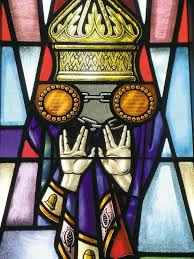A mudra that links Star Trek, Orthodox Jewish liturgy, and the god of witches.
Fascinating.
The “Vulcan salute” premiered in 1967 during Star Trek's second season. Series creator Gene Roddenberry felt that the words of the newly-invented Vulcan greeting needed some sort of physical gesture to go with them. Actor Leonard Nimoy held up his hand, palm facing out, thumb extended, fingers divided between the second and third fingers. In that moment, a pop-culture icon was born. Live long and prosper, folks.
Nimoy knew the gesture from his childhood. Six times a year in the Orthodox synagogue that his grandfather took him to, the kohanim—men from priestly families—would face the congregation, raise both hands before their faces making the same hand-sign, and pronounce the ancient Threefold Blessing:

Adonai bless you and guard you.
Adonai cause his face to shine on you.
Adonai raise his face to you and give you shalom.

Jewish tradition associates the hand-sign with the letter Shin, for the divine name Shaddai, “He of the Mountain.”
But in his 1964 book Pagan Rites in Judaism, Freudian analyst Theodor Reik (1888-1969) tells a different story.

According to Reik, the hand-sign dates back to times when, like every other high god in the ancient Middle East, the god of the Hebrews was worshiped in the form of a bull (think Golden Calf). Thus, the priests are blessing the people with the Sign of the Hoof.
Reik's thesis is historically unverifiable. The gesture dates at least from the late Second Temple period, since it is preserved in Ashkenazic (Northern European), Sephardic (Mediterranean) and Mizrachi (Middle Eastern) Jewish liturgies and must therefore antedate the division of those communities late in the first century CE. Further back we cannot trace it.
Archaeological findings make it clear that the Bull thesis, at least, is correct. The Torah confirms it: El ha-motziam mi-Mitzrayim, ke-to'afot re'em lo: “El, who brought them out of Egypt, has horns like an aurochs” (Num. 23:22, 24:8). Whatever they may tell you in synagogue, church, or mosque today, it's clear that “God” used to have horns.
For some of us, he still does. Horned gods are ipso facto hoofed gods as well. The god of the witches is well-known for his “Bull Foot.” “Old Clootie,” they call him: “Old Cloven [Hoof].”

Reik's theory, whatever its historicity, strikes some deep historical resonances. The ungulates—hoofed animals—first emerged during the Eocene (“Dawn Age”) epoch (56-33.9 million years ago). Possibly because they lived in marshy areas, they began to walk on tip-toe, en pointe. It would seem that the nails of the second and third toes eventually enlarged and thickened to become the cloven hoof.
Divided between the second and third digits. Just like the hand-sign. Truly, one wonders.
Along with the more familiar sign of the Horns, the sign of the Hoof has its place in contemporary Old Craft practice as well, used informally as a sign of both invocation and aversion, and formally in blessings, generally with the arms raised in orans position.
So today I raise my arms, spread my hands, and speak the old, good words:
By the sign of the Cloven Hoof be hale,
and in Old Hornie's name.